There’s no one as famous in the world of horror manga today as Junji Ito. He has rightfully amassed a cult following around the globe.
And yet, Junji Ito is not merely a horror mangaka. In my opinion, he’s one of the greatest horror artists of our time. If you’re a fan of horror and especially horror manga, you will certainly stumble upon his works.
Junji Ito’s body of work is as strange as it is unique. Reading his manga feels like going down a tiny, very special rabbit hole unlike any other.
Table of Contents
- Discovering Junji Ito
- Junji Ito – Works and Style
- Cosmic Horror
- Visual Style and Narrative Themes
- Junji Ito’s Visual Style
- Junji Ito’s Narrative Themes
Discovering Junji Ito
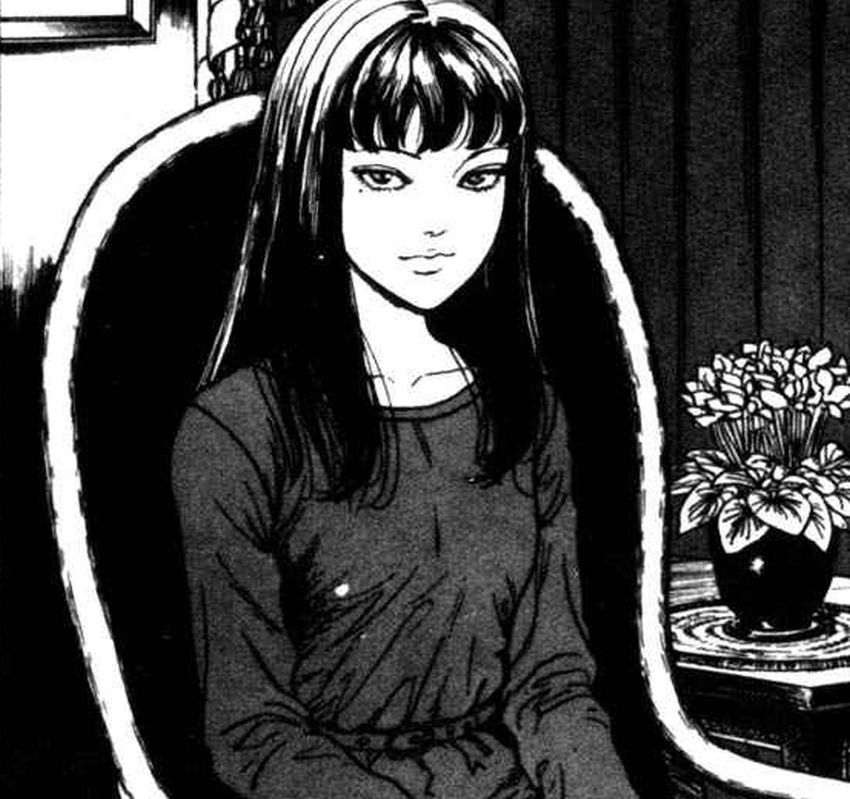
I first learned about Junji Ito a decade and a half ago. At the time, I was searching online for new horror manga to read. At the time, I was still new to the genre, but the prospect of a manga that was supposed to ‘give me nightmares’ sounded interesting enough.
That manga was Tomie. When I finally read it, it was everything I desired in a work of horror and much, much more. It was full of outlandish ideas and terrifying imagery.
The next manga by Junji Ito I read was Gyo, which was as nightmarish as Tomie, but much more surreal, weird and absurd. Junji Ito’s style, however, was as fantastically disturbing and nightmarish as in Tomie.
What finally sold me and made me a lifelong fan of his works was Junji Ito’s masterpiece, Uzumaki. It’s the story of the small coastal town of Kurouzu-cho which is haunted by spirals. The story was outlandish, the imagery disturbing, and it was completely unique and different from any other horror manga I’d read until then. If you want to learn more about Uzumaki, I put together a short article about my favorite Uzumaki chapters.
Over the years, I’ve read countless horror manga, both by well-known and lesser known writers, as you can see in the list of my favorite horror manga. Still, Junji Ito’s works hold a special place in my heart and are, in my opinion, among the best horror manga of all time. His works are so strange, so unique and outlandish, I find myself going back to them time and again.
Junji Ito – Works and Style
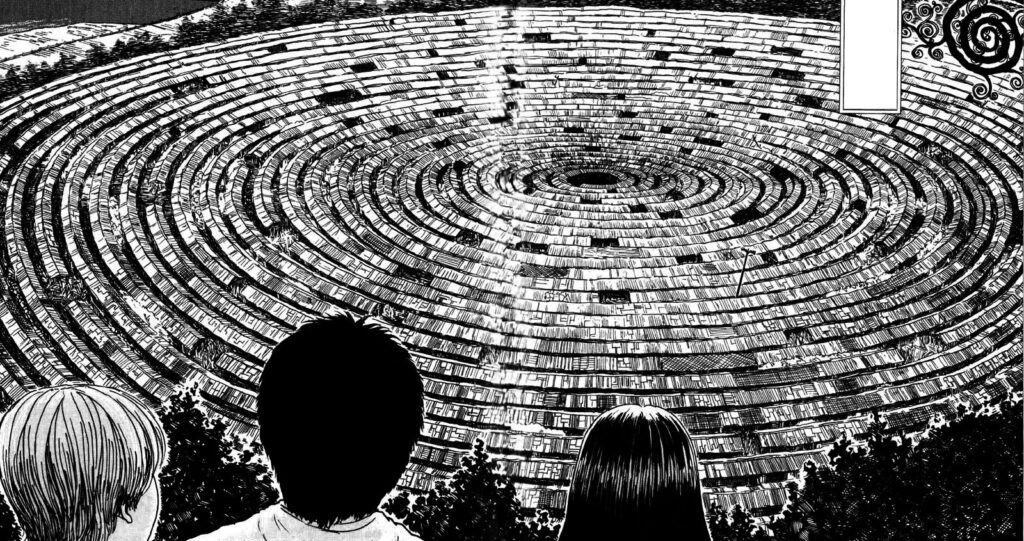
What makes Junji Ito’s works so fantastic is his blend of outlandish and, at times, supernatural horror with the mundane things in life.
Junji Ito’s work truly shines because it’s a very special kind of horror. His works seldom feature killers or monsters. Instead, Junji Ito’s horror is often unexplained, comes from powers outside of our influence or it comes from our very own faults, fears, obsessions and phobias.
Sometimes his premises are strange, even ridiculous, but Junji Ito makes it all work. The idea of a town haunted by spirals becomes one of the most disturbing and unique horror works of all time. Balloons taking on the faces of people and hunting them down becomes a nightmarish apocalypse. Even a story about human-shaped holes revealed after an earthquake become a setting of outlandish existential horror and deadly curiosity.
Junji Ito’s works stand out for their blend of masterful imagery and the narrative themes featured in them. It’s especially interesting to note that Junji Ito’s nightmarish imagery and disturbing ideas often hide deeper themes or things to ponder about.
Cosmic Horror
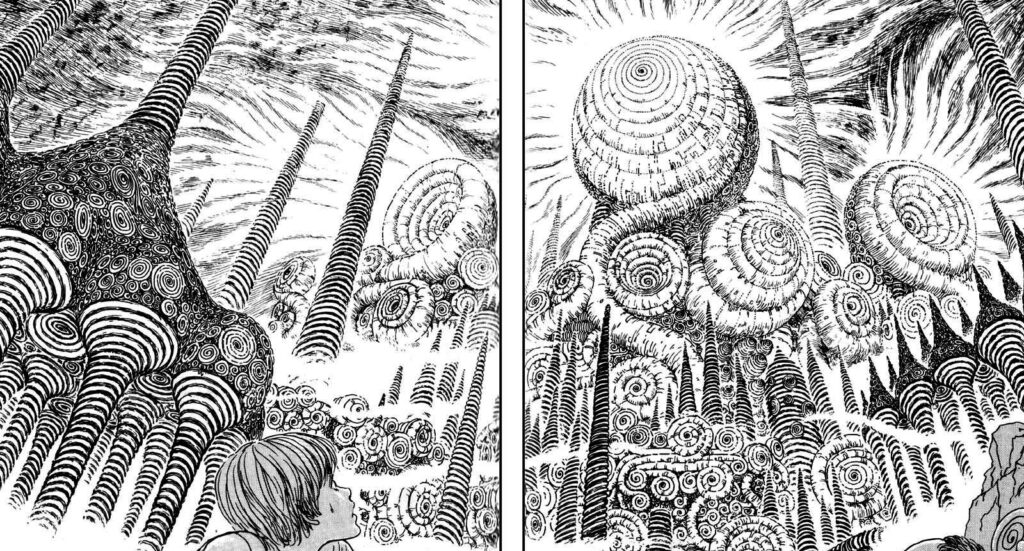
Once can’t talk about Junji Ito without first discussing cosmic horror.
The genre was created by American Horror writer H. P. Lovecraft. It centers on the idea that the most horrible thing is the realization that humanity is ultimately meaningless in the greater scope of the universe. Even worse, there are powers and beings out there that are far older and far more powerful that we could ever imagine. They are entities that were around long before man first emerged and will be so long after we’re gone again. Our lives, our dreams, our problems, they are all meaningless in the greater sense of the cosmos.
While Junji Ito’s influenced by H. P. Lovecraft, he still created his very own blend of cosmic horror. It’s one that’s often weirder and stranger than what was seen in Lovecraft’s work. Humans are powerless in Junji Ito’s world, but while some of his works, like Uzumaki, feature unknown powers or entities, most of his work focuses on more intimate and mundane things.
Another similarity is that cosmic horror and Junji Ito’s works seldom feature central villains or antagonists. We don’t encounter evil in the traditional sense. Instead, it’s our own realizations or inexplicable powers that are at the core of cosmic horror.
Visual Style and Narrative Themes
In the main part of this article, I want to discuss both Junji Ito’s visual style and his narrative themes. They both make Junji Ito’s work unique and make it stand out amongst a plethora of other graphical horror works.
Junji Ito’s Visual Style
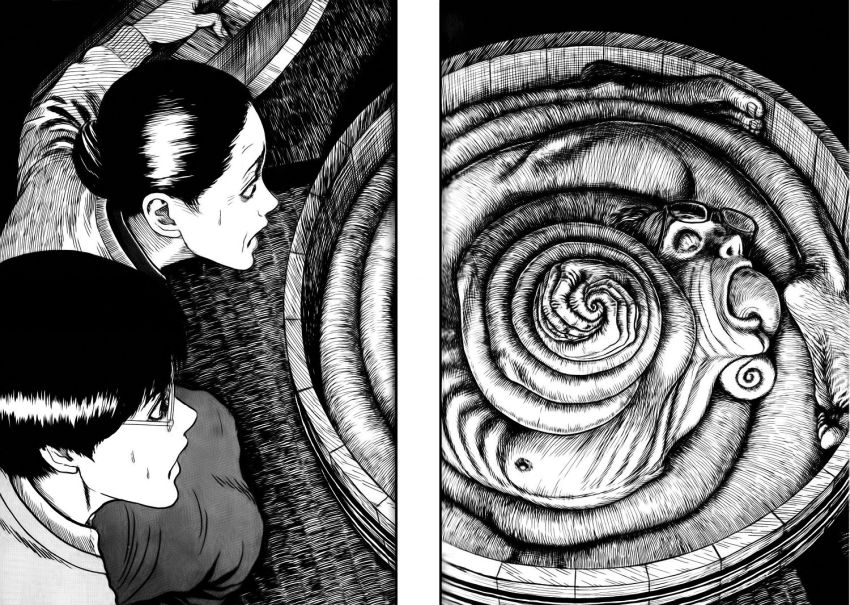
Junji Ito’s works are well known for his own personal style. He brings forth his horrors by a combination of masterful ink work and line work.
Junji Ito uses his detailed line work and a reliance on bold, almost unsettling inks to present his grotesque and shocking imagery. While he uses shading, his work mostly relies on lines to show textures. Even his gore and many of his unsettling details, like blood and wet, squishy details, are rendered with nothing but lines. This serves to give them not only a unique look, but adds much more detail and gives them a more visceral and disgusting quality.
Another concept Junji Ito heavily uses is contrast, both in environments and in characters.
His visual style, however, is most prevalent and recognizable in his characters. Junji Ito’s characters never blush and seldom show signs of normal happiness. Instead, they are often devoid of normal emotions and all he shows us are over-exaggerations.
Junji Ito’s characters often look empty and lifeless even before the horror happens. This is most often the case in his stories that focus on personal horror or mental illnesses. You can truly see how bad his characters feel and how close they already are to the abyss that’s eventually going to swallow them up. Their faces are characterized by fallen in cheeks and their bodies are often sickly thin, almost skeletal-like. Dark circles around the eyes and abnormal irises often help to showcase dark emotions, such as depression and gloominess.
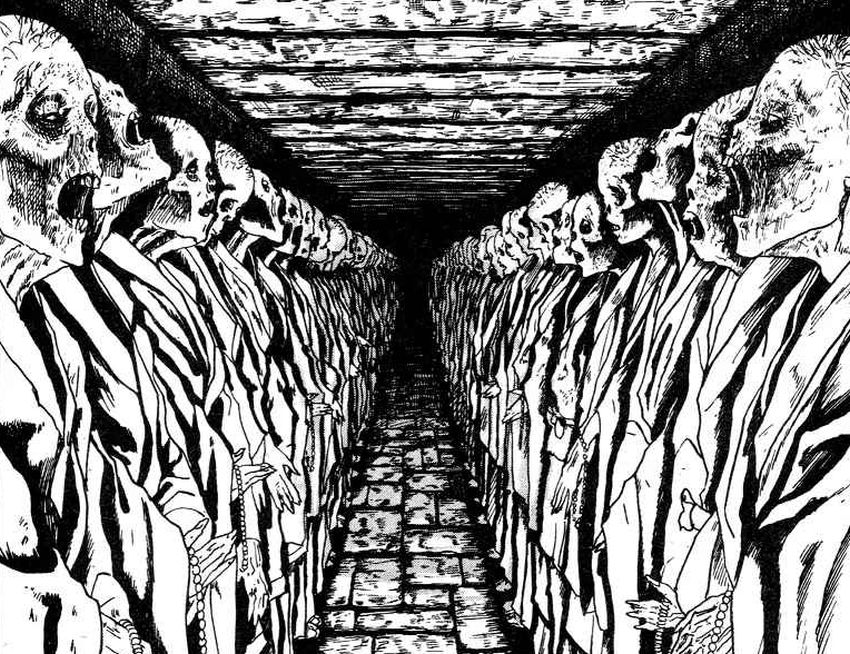
This effect is used by minimal shading and heavy contrast between certain elements of the person’s face. Ito often focuses on the eyes, the mouth, and uses them to show nothing but unnatural emotional reactions.
His characters often wear creepy facial expressions. Be it smiles, be it sad looks, they are all disgustingly accentuated, giving them an entirely surreal feeling.
Once the true horror of a story happens, however, Junji Ito goes all out when showcasing a person’s emotional response. Terrified facial expressions are often so overdrawn they make us uncomfortable. Mouths are wide agape, faces are distorted and elongated as they scream and eyes are wide open.
Another element that makes Junji Ito’s works so unique is his reliance on body horror and the distortion of the human body. He doesn’t rely on monsters to scare us, instead his horror is often related to our own bodies. People are being twisted, become warped and turn into forms barely resembling human beings. We see people turning into spirals or becoming rotten abominations and elongated versions of themselves.
It’s this reliance on body horror that makes Junji Ito’s work so terrifying. Often, the horror of his stories doesn’t come from outside, but from within our very own bodies. It’s both strangely fascinating, but also highly disturbing.
Junji Ito’s Narrative Themes
As a writer, I’m often fascinated by Junji Ito’s works. It’s not only for their visual representation, but also for the narrative themes he employs. While his works are graphic, he uses a variety of narrative themes and elements to bring forth his own blend of horror.
Junji Ito’s works are bizarre, even absurd, but incredibly creative. His characters, as well as his settings, however, are often as mundane as can be, at times even boring.
His themes often center on fears, obsessions and phobias and showcase what happens when people give into them. And yet, many of his works hide deeper themes, a deeper meaning that might not be visible at first glance.
I want to discuss all of those elements in detail below.
Story-telling Conventions
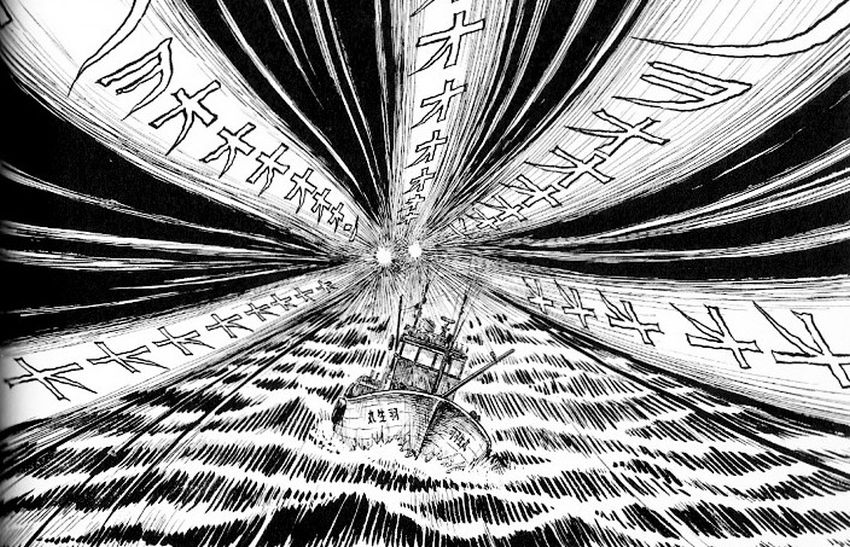
Junji Ito’s work doesn’t follow normal or traditional story-telling conventions.
Most of his characters aren’t characterized and there’s no character development throughout his work. Instead, characters are often blank slates, or merely exist to showcase a certain fear, phobia or obsession.
The same is true for the plot. Junji Ito’s works seldom rely on an engaging or interesting plot. Instead, he merely gives us a glimpse into someone’s life and lets us witness the horrible things that happen to them. More than anything, Junji Ito’s works are about atmosphere, about horror and the gruesome demise of his characters.
While Junji Ito writes horror stories, there’s seldom a feasible antagonist. People are haunted by faceless entities, curses, higher powers, or by their very own psychological problems.
One of the biggest problems in horror writing or horror stories is the need to explain what should be inexplicable or adding too many details. Junji Ito seldom does this. Instead, he leaves us with the mystery, leaves us guessing and fearing the unknown. One of the best examples is his story Hanging Balloons. We never get an explanation what those balloons are, where they came from or why. Instead, he only shows us what happens after they appear. He lets us watch it through the eyes of his characters and ends it when their time on the screen is over. The mystery remains intact and, with it, the horror.
Gyo is an example of a story where Junji Ito breaks this convention. Near the end, he tries to give a scientific explanation for the apocalyptic horror that unfolded and, at least to me, it didn’t work. Instead, it seemed silly, almost comically absurd, and almost ruined the manga for me.
The Mundane and the Normal
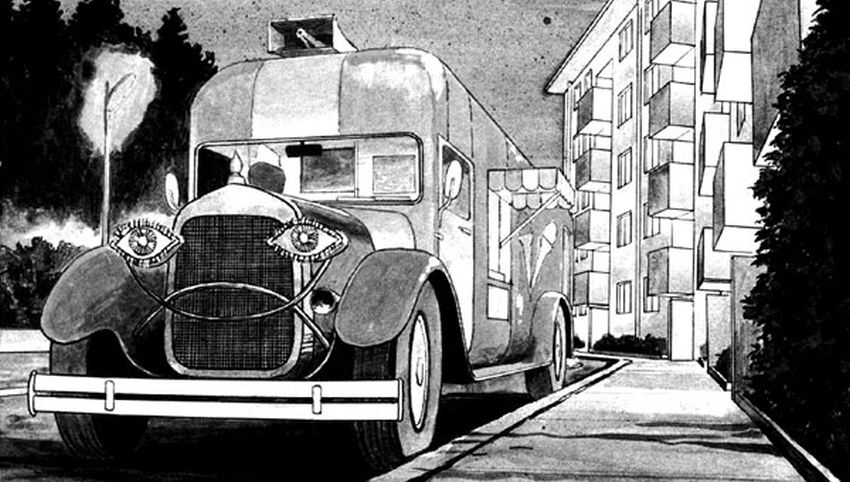
Junji Ito’s stories often begin in normalcy. We don’t start with a dramatic backstory or by introducing an antagonist. Instead, his stories begin in the most mundane places. We watch characters going to school, falling in love or having to go to the hospital. It’s here in these normal, mundane settings that Junji Ito slowly introduces his horror elements.
The same is true for the horror themselves. In many stories, Junji Ito’s horror comes from the most mundane places or is caused by mundane objects: musical records, laughter, hair and even concepts such as spirals.
Many of his stories feature normal or ordinary fears such as the unknown depths of the ocean, claustrophobia, being watched, a sweaty, dirty mattress or holes in a wall. Yet, Ito drives them up a notch. He twists them into something irrational and surreal, blows them up and turns them into crazy phobias. At the essence, though, those are often fears or thoughts that plague many of us.
And yet, Junji Ito twists these mundane settings and tortures his normal characters until his stories turn into a world of horror. What started out as a normal, everyday scenario becomes uncomfortable to watch, has been warped and now the surreal and disturbing reigns supreme.
It’s this that makes Junji Ito’s work so special and unique. This contrast between the mundane and the horrors he conjures. We see it most in his characters. Their mundane, almost expressionless faces get twisted and turned into masks of terror with over-exaggerated details that are barely resembling them. It’s almost as if not only the story but also his characters get warped into something entirely different, something horrible.
There are also some stories by Junji Ito that are grounded in reality. A great example is The Bully, which serves to be one of his most realistic, but also most terrifying, works.
Characters
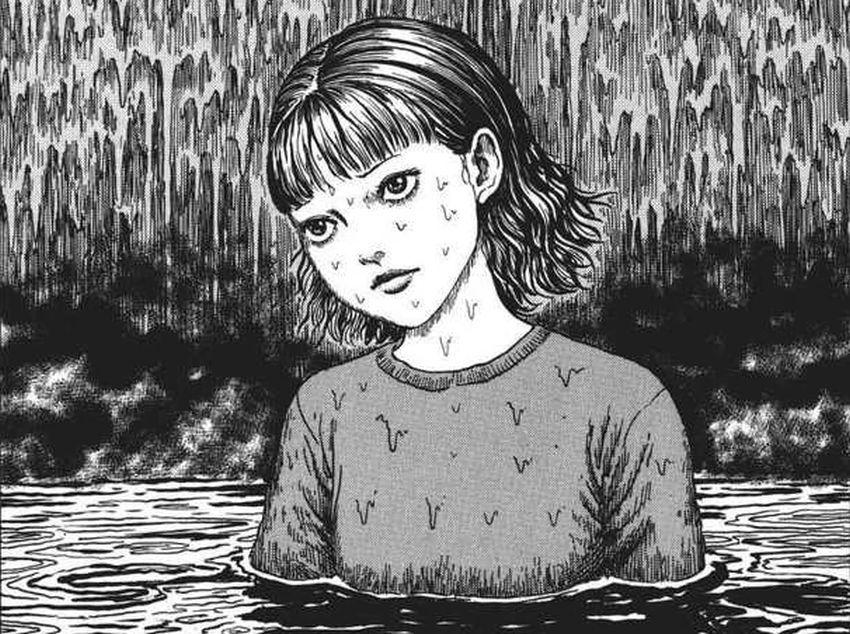
It’s not only Junji Ito’s stories that are normal and mundane but also his characters. They are nobodies, often blank slates who become involved with Junji Ito’s horrors.
They are often students or normal day people who lead a normal life. His characters are never the heroes of their stories, they are never smart or resourceful protagonists. Instead, they often serve as nothing but a vessel. Through them Junji Ito gives us a glimpse into his world of horrors.
Even worse, though, sometimes his characters are dumb and driven on by their curiosity or desires. And yet, if his characters show strong emotions, it’s almost always a singular one. Their fear, phobia or desire becomes their defining character trait, often the only one they showcase, and that ultimately leads to their demise.
Junji Ito’s a fantastic writer and artist, but he’s not a character writer. No, his characters are merely there and seem to be nothing but lambs waiting to be slaughtered.
Irrational Fears
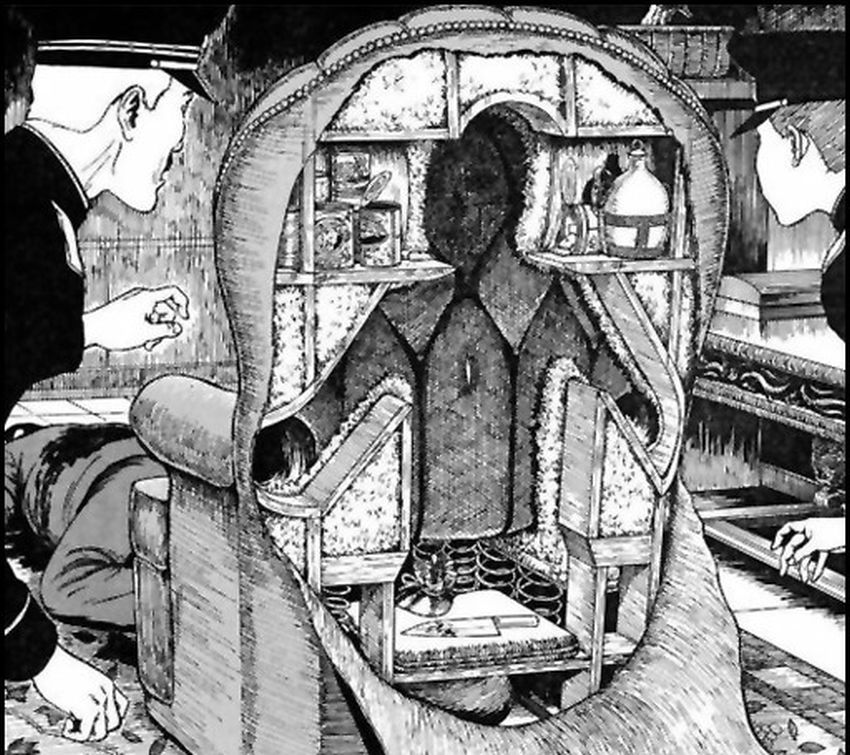
We all know irrational or childish fears. When we were young, we were all afraid of the monsters under our bed, of the doctor, strange neighbors, or even shadows.
As adults, we understand that those are nothing but irrational fears. There’s no boogeyman, and there are no monsters out to get us.
Junji Ito’s work, however, often features exactly these fears. This often gives them an uncanny feeling because we recognize those scenarios. We too were afraid to visit the doctor, and we too were afraid of the monsters under the bed and even know we have our own eccentricities and phobias. And Junji Ito explores and exploits them. He takes the most irrational and silly fears, gives them life and as a result his stories so much more terrifying.
Body Horror
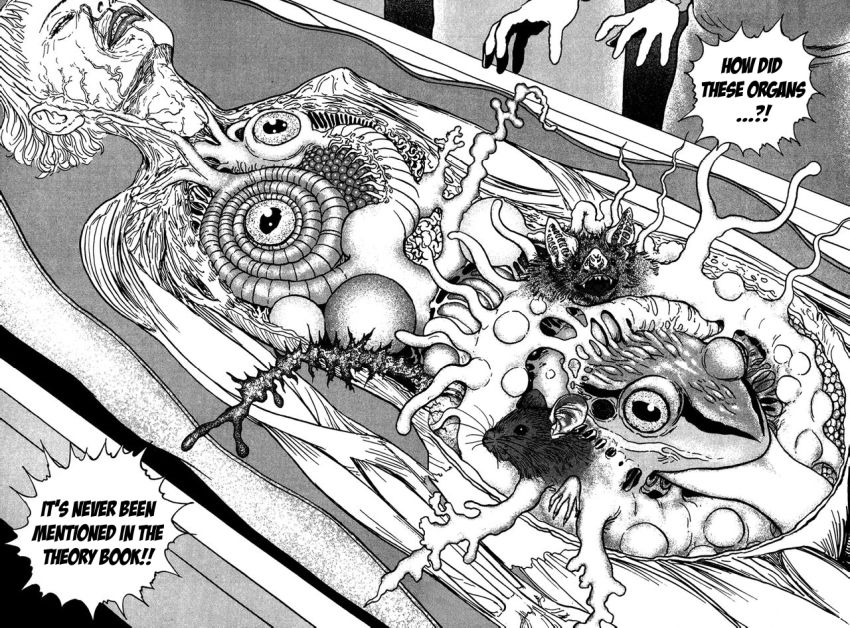
Junji Ito’s a master of body horror. He isn’t just satisfied by people dying. Instead, he often distorts, warps, and twists them. This is not merely visible in their ultimate demise, but also in the way people change over the course of his stories. People who start out by looking normal, even beautiful, become haunting, sick versions of themselves or turn insane as their sanity shatters.
Two of Junji Ito’s greatest examples of body horror are Dissection Girl and Uzumaki. The first features a disturbed woman who wishes to be dissected. Her wish is ultimately granted at the end of the story and showcases one of Junji Ito’s most fantastically disturbing panels. For it is revealed that it’s not only her mind that was heavily distorted but also her body. Uzumaki, on the other hand, is a three volume masterpiece about a small town haunted by spiral. Over the course of the story, many of its inhabitants become obsessed with spirals and are warped and twisted until their bodies represent the spiral in various horrible ways.
Junji Ito’s brand of body horror is always a disturbing delight to look at and one that often renders his characters almost unrecognizable.
Mental Horror
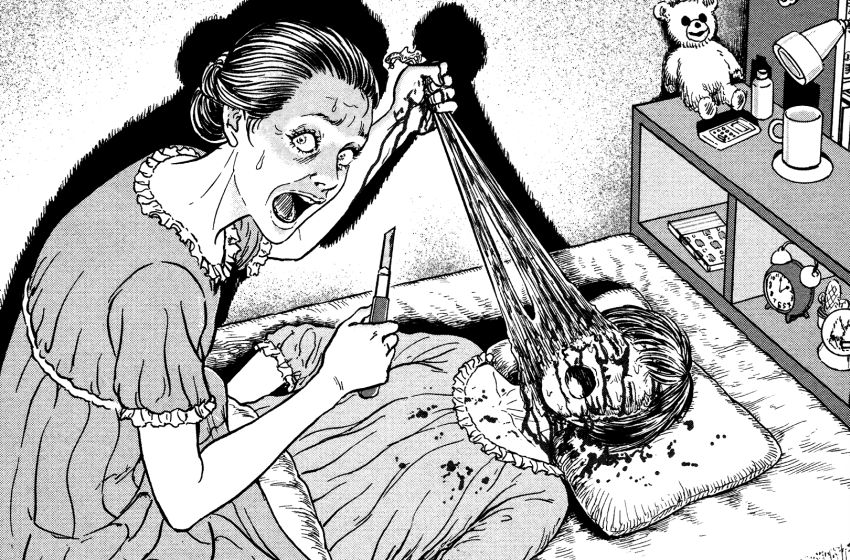
One of Junji Ito’s most common tropes is that of mental illness. Depression, fears, phobias and obsessions are often the center point of his stories.
Yet, Junji Ito isn’t satisfied by exploring them. Instead, he uses them as a basis for the madness in his stories. Many times, an irrational fear or phobia is merely the starting point and. Over the course of the story, he amplifies and distorts them until they end in utter madness and insanity.
His characters’ mind gets distorted and changes similarly to their bodies. While their eyes become large and bulging and their mouths hang agape in terrible screams, their minds, too, are inevitably broken.
Powerful emotions and general erratic and irrational behavior are widely featured in his works and are almost commonplace amongst his characters. They are eccentric weirdos, people whose entire being or character revolves around a single trait, often their very own blend of mental illness, fear or phobia.
Obsession is the leitmotif in Junji Ito’s Tomie which features a woman so beautiful any man who sees her becomes obsessed with her. Many other stories, too, feature obsession. It can be caused by love, by animosity, jealousy or even the obsession of owning a certain object. And each of these stories ends with people giving into their obsession, being changed by it and ultimately leading to dire results.
Love, too, is something Junji Ito often exploits and distorts. What might start as a harmless crush will soon turn into a dangerous obsession that drives people mad. Great examples are again the aforementioned Tomie, but also other works such as The Lovesick Dead or the chapter Jack-in-the-box in Uzumaki.
Insanity, Despair and the Inevitable End
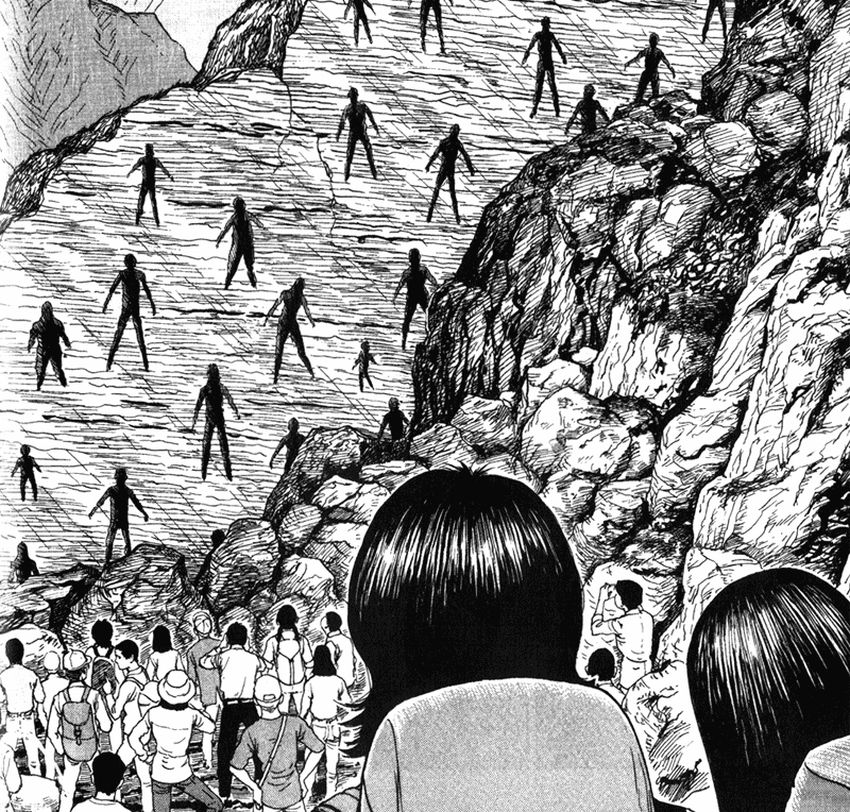
As mentioned before, Junji Ito often drives his characters’ fears and phobias to the max and turns them into despair and insanity.
The reason for this, however, is often because his characters are inevitably doomed. Similar to the characters in the works of Franz Kafka or H. P. Lovecraft, Junji Ito’s characters have no power over their world.
We can see it best in Uzumaki. In it an entire town becomes an inescapable hell and characters realize that there’s no hope, no way out anymore. In a similar way, The Enigma of Amigara Faults toys with our curiosity, but also with inevitable fate. People flock to the strange holes that resemble them and, driven by an almost supernatural, primal urge, they are overcome with a curiosity they can’t seem to fight.
Existential dread is something at the core of our very being. As humans, we are the only beings on this planet who know that they will die one day and there’s nothing we can do about.
Junji Ito’s stories are full of this existential dread and horror, but his world is one that’s far more unforgiving than our own. It’s a place far more dangerous and far weirder and messes with its characters. The horror often comes in the most mundane forms and it shows that nothing is safe in the world of Junji Ito. There are no safe spaces and even the most mundane thing can lead to a terrible, horrible incident.
Deeper Meaning and Themes
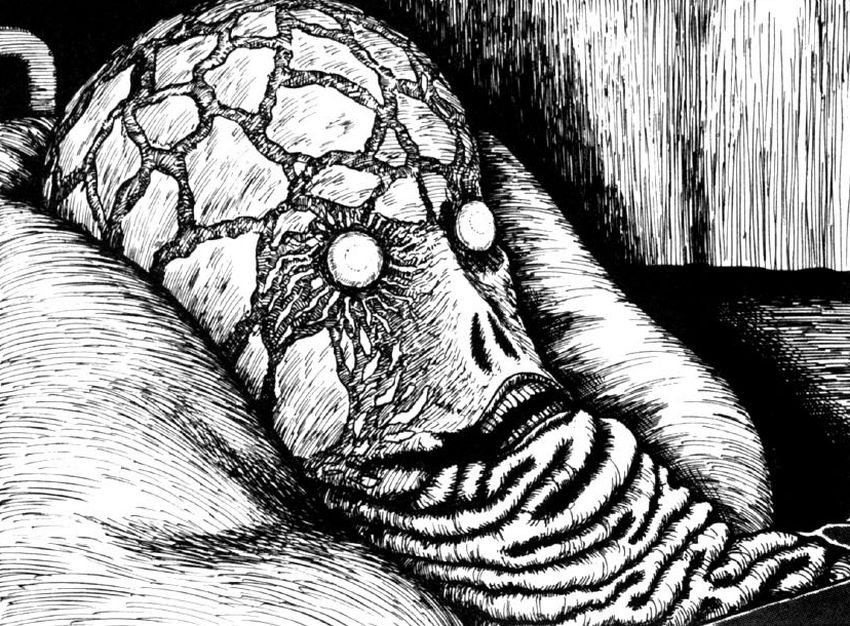
While Junji Ito’s work relies on supernatural forces and mental instability, many of his works feature deeper themes.
Town Without Streets is a prime example. In it, Junji Ito discusses privacy and twists it to its extremes. What would you do if there was no more privacy? Would you reject the notion of such a world and do anything against it, or would you accept and discard the idea of privacy all together? It’s a topic that’s even more relevant today.
Another fantastic example is The Long Dream. It poses the question if endless dreaming could be a way to defeat death itself. Is it a better choice to be trapped in a dream forever than to die? Is even a never-ending nightmare better than to cease existing?
Isolation is another dominant theme in Junji Ito’s work. As mentioned before, many of his characters suffer from problems and not a few isolate themselves from society.
Junji Ito features a different idea of isolation in his story, Army of One. Safety in numbers is usually common rule in horror. In Army of One, however, he twists this idea, and it’s those who stay alone, who isolate themselves that are safe. It’s a strange story, but one that’s ripe with deeper meaning. It seems almost to point at our urbanized society and the forced social interactions so common in it and especially in Japan. Is it ultimately a better choice to stay on your own than to mingle and take part in this often forced social life
Lingering Farwell is a study of holding on and not accepting the death of loved ones and also one of Junji Ito’s best stories of all time.
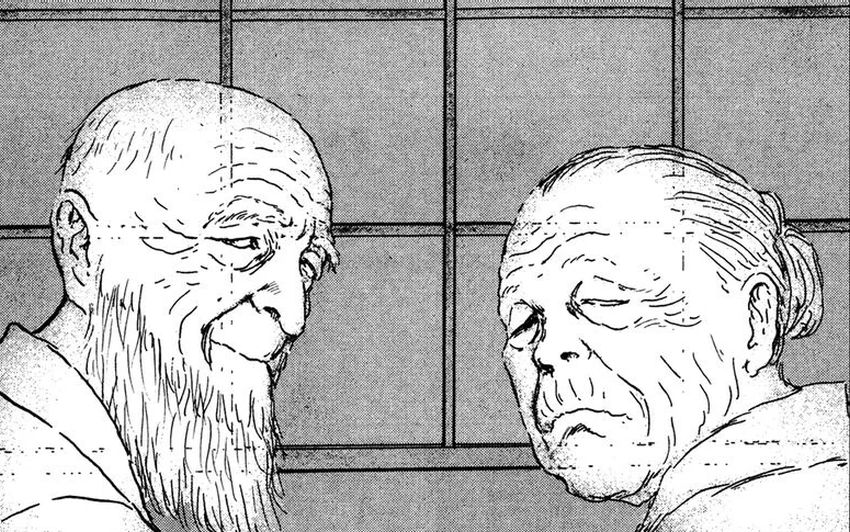
Black Paradox is one of Ito’s weirdest stories, but in its later parts brings forth an interesting question. In the story’s context, it’s using our own souls as a new source of energy. It’s clear, however, that the story centers on the idea of humanity bringing its own demise. Would we, too, bring our own end because of our greed and hunger for power?
Hanging Balloons is a story that might at first glance seem utterly nonsensical, but once more there’s more here than meets the eye. The very first person to die is Terumi, an idol. If one’s familiar with Japanese pop culture and the idol business, one knows suicides are an unfortunate reality. But the story isn’t merely a criticism of the idol business.
Similar to The Enigma at Amigara Faults, the story is a discussion of Sigmund Freud’s ‘Death Drive,’ our own fascination with suicide and the compulsive need to follow our desire towards destruction. Most of us ignore those thoughts, but there are still some who don’t.
While The Enigma at Amigara Faults showcases the characters’ strange, almost supernatural obsession with finding out more about their holes, Hanging Balloons takes a different route. The balloons Junji Ito features are almost a personification of the ‘Death Drive’ and the story itself is an allegory of it catching up and preying upon people.
Many similar examples show that while Junji Ito’s predominantly an artist who creates visual nightmares, his works often hold deeper meaning.
It’s always interesting for me to think about how works as bloody, surreal and twisted as those of Junji Ito can also convey deeper themes. It gives them an entirely different layer and something to ponder about when one’s not satisfied by just gore and blood alone.